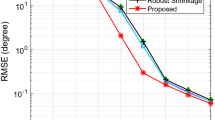Abstract
This paper analyzes two direction-of-arrival (DOA) estimation algorithms used in the presence of multipath propagation and with very few snapshots. The conditional maximum likelihood (CML) algorithm and the method of direction estimation (MODE) are discussed. The estimates provided by these algorithms are shown to coincide for large number of snapshots or large signal-to-noise ratio. Necessary and sufficient conditions are derived for the algorithms to yield unique estimates. It is shown that their uniqueness conditions coincide with the minimal uniqueness condition on the array, that is independent of the algorithm used (if the array does not satisfy this minimal condition, no DOA estimation method can give unique estimates). Numerical examples are presented to demonstrate the theoretical results.
Similar content being viewed by others
References
P. Stoica and A. Nehorai, MUSIC, Maximum Likelihood, and Cramér-Rao Bound,IEEE Trans. Acoust. Speech Signal Process., vol. 37, pp. 720–741, May 1989.
P. Stoica and A. Nehorai, Performance Study of Conditional and Unconditional Direction-of-Arrival Estimation,IEEE Trans. Acoust. Speech Signal Process., vol. 38, pp. 1783–1795, October 1990.
M. Wax, Detection and Estimation of Superimposed Signals, Ph.D. Dissertation, Stanford University, Stanford, CA, March 1985.
D. Starer and A. Nehorai, Conditional and Unconditional Maximum Likelihood Estimation of the Parameters of Exponential Signals in Noise, Report No. 8914, Center for Systems Science, Yale University, New Haven, CT, May 1989.
P. Stoica and K. Sharman, Maximum Likelihood Methods for Direction-of-Arrival Estimation,IEEE Trans. Acoust. Speech Signal Process., vol. 38, pp. 1132–1143, July 1990.
M. Wax and I. Ziskind, On Unique Localization of Multiple Sources by Passive Sensor Arrays,IEEE Trans. Acoust. Speech Signal Process., vol. 37, pp. 996–1000, July 1989.
T. W. Anderson,The Statistical Analysis of Time Series, New York, Wiley, 1971.
J. A. Cadzow, Y. S. Kim, D. C. Shiue, Y. Sun, and G. Xu, Resolution of Coherent Signals Using a Linear Array,Proc. Int. Conf. on Acoustics, Speech, and Signal Processing, pp. 37.4.1–37.4.4, Dallas, TX, April 1987.
B. Ottersten and M. Viberg, Analysis of Subspace Fitting Based Methods for Sensor Array Processing,Proc. Int. Conf. on Acoustics, Speech, and Signal Processing, pp. 2807–2810, Glasgow, May 1989.
Y. Bresler and A. Macovski, On the Number of Signals Resolvable by a Uniform Linear Array,IEEE Trans. Acoust. Speech Signal Process., vol. 34, pp. 1361–1375, December 1986.
T. Söderström and P. Stoica,System Identification, London, Prentice Hall, 1989.
P. Stoica and K. Sharman, Novel Eigenanalysis Method for Direction Estimation,Proc. IEE-F, vol. 137, pp. 19–26, Feb. 1990.
Author information
Authors and Affiliations
Additional information
The work of A. Nehorai and D. Starer was supported by the Air Force Office of Scientific Research under Grant No. AFOSR-90-0164 and by the Office of Naval Research under Grant No. N00014-91-J-1298.
Rights and permissions
About this article
Cite this article
Nehorai, A., Starer, D. & Stoica, P. Direction-of-arrival estimation in applications with multipath and few snapshots. Circuits Systems and Signal Process 10, 327–342 (1991). https://doi.org/10.1007/BF01187549
Received:
Issue Date:
DOI: https://doi.org/10.1007/BF01187549




